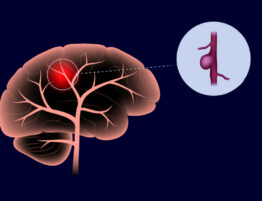Are you curious about what is a brain aneurysm and how it can affect your health? Get ready to unravel the mystery behind this silent threat. A brain aneurysm is like a hidden time bomb in your head. Therefore, understanding its causes, signs, and symptoms is crucial to your well-being.
Imagine that your brain is a powerful engine of thought and action. Except it’s facing potential dangers. In this guide, we’ll break down the basics of a brain aneurysm. You’ll learn what triggers it, what red flags your body may be giving you, and what subtle cues you shouldn’t ignore.
Join us on this journey. You will be able to understand the world of brain aneurysms and arm yourself with knowledge. It can make all the difference. Let’s dive into the essentials and decipher the language your brain may be whispering about your well-being.
What is a Brain Aneurysm?
A brain aneurysm is like a small balloon. You can get one on a blood vessel in your brain. Think of it like a weak spot in a water hose. It’s a tiny bulge that can lead to more significant problems. The causes? They’re unclear, but high blood pressure and certain medical conditions can play a role. Why should you care? Because, unfortunately, you can get a brain aneurysm rupture. And unfortunately, it can lead to severe problems.
Recognizing a brain aneurysm is not easy. That’s because it usually doesn’t show symptoms until too late. But sometimes, mild warning signs can appear. But usually, people don’t pay attention to these first symptoms. That’s because they can be confused with some other diseases.
Imagine this: your brain is the control center of your body. And even a tiny balloon can disrupt the entire system. Understanding the nature of a brain aneurysm is very important. Because armed with knowledge, you can take steps to prevent or treat it. Be informed, be vigilant – your brain will thank you.
What Causes a Brain Aneurysm?
Now, what’s behind the scenes of a brain aneurysm? First of all, let’s look at the causes of the disease. These hidden factors could underlie the development of this potentially serious condition. Like a detective on a mission, we’ll unravel the mysteries that lead to the formation of these tiny balls in the blood vessels of the brain. From high blood pressure to genetic factors. Trust us, the culprits may be closer than you think. Understanding what causes a brain aneurysm is the first step to keeping your brain healthy. So grab your detective hat and explore the intriguing world of aneurysm causes.
Genetic Factors
When it comes to the causes of brain aneurysms, genetics plays a role like a silent script in the background. Imagine your family history is a narrator, relaying stories about health traits. These genetic scripts may include a propensity to develop brain aneurysms and their symptoms. Have your close relatives experienced this problem? It may increase your own risk. It’s like a secret code in your DNA that can affect the strength of your blood vessels. While you can’t rewrite your genetic script, it’s essential to recognize this family connection. It will help you stay vigilant and proactively maintain your overall health.
Hypertension (High Blood Pressure)
The silent villain in the world of brain aneurysms is high blood pressure, also known as hypertension. Think of your blood vessels as sturdy pipes. They should be able to handle the flow of blood easily. When your blood pressure is constantly elevated, it’s like increasing the pressure in those tubes. Over time, this stress weakens the walls of the blood vessels. And that creates a favorable environment for a brain aneurysm to occur. It’s like expecting a garden hose to withstand too much water pressure. Something’s bound to fail. Keep an eye on your blood pressure. That’s one way to prevent brain aneurysms.
Trauma or Injury
Picture this: the brain, resilient yet vulnerable. It faces a potential threat – injury or damage. Of course, our skull protects this vital organ. However, a sudden blow or injury can still lead to a brain aneurysm. It’s like a delicate dance between a protective shield and unexpected forces. A blow can weaken blood vessel walls, whether it’s a fall, car accident, or sports injury. It creates a breeding ground for these insidious balloons. Understanding the link between trauma and aneurysms is critical. It allows us to prioritize safety measures. You can protect your brain from life’s unexpected twists and turns.
Atherosclerosis
When asked what causes a brain aneurysm, it’s safe to say atherosclerosis. Imagine that your blood vessels are thoroughfares designed to move freely. Now imagine that they are always clogged with fatty deposits – atherosclerosis. Over time, these deposits can become a bumpy road. It causes stress on the vessel walls. Think of it as a traffic jam that weakens the infrastructure. In the brain, this stress can lead to aneurysm formation. Controlling your cholesterol levels and living a healthy lifestyle is how to relieve traffic on this crucial thoroughfare. You will reduce your risk of these unwanted obstructions.
Smoking
Familiarize yourself with the infamous accomplice of a brain aneurysm – smoking. Imagine that your blood vessels are a delicate network designed to maintain harmony. Now, imagine that smoking is a disruptor, releasing harmful substances. They are what weaken those blood vessels. It’s like exposing a fragile bridge to corrosive elements. The toxins in tobacco create a risky environment. They make the vessel walls susceptible to damage and the insidious appearance of an aneurysm.
Signs and Symptoms of Brain Aneurysm
Have you ever wondered how your body can give subtle hints of a possible brain aneurysm? Let’s journey through the signs and symptoms – the body’s coded messages. They communicate that something is wrong in the confusing realm of your brain. Think of it as the secret language your body speaks. It’s urging you to pay attention.
From unexplained headaches to unusual vision changes. These signals can be like whispers of a potential threat. Understanding these signals is like deciphering a hidden code. You can gain insights that make all the difference in dealing with a potential aneurysm. So, let’s unravel these mysteries together. We’ll decipher the language your body can use to communicate how you feel.
Severe Headache
Enter the house with the herald of a bad headache. Think of it as a warning sign. It’s your body’s way of waving a red flag. It’s not just a headache; it’s a unique, intense pain that demands attention. This throbbing sensation can be like an alarm bell. It signals something unusual going on in your brain.
Of course, headaches are common. But sudden and severe pain can be signs and symptoms of a brain aneurysm. It’s as if your body is saying, “Hey, something’s wrong here!”. It is essential to realize the seriousness of this signal and seek help promptly. It will be a crucial move for your brain health and keep you one step ahead of potential threats.
Neck Pain and Stiffness
Feeling the strain? Pain and stiffness in your neck may be your body’s way of signaling an alarm. Your neck is the bridge that connects your head and body. If something is compromised in it, such as a brain aneurysm, it feels like an obstruction, causing discomfort. This pain and stiffness can be brain aneurysm symptoms. They are like warning signs on the road, urging you to pay attention.
Neck problems have a variety of causes. But sudden and acute stiffness can be your body’s signal of potential problems in the brain. Recognizing these signals and seeking help promptly means removing obstacles. You’ll ensure that your body’s vital communication network runs smoothly.
Vision Problems
Blurred vision or sudden vision problems can be your body’s Morse code. It accurately signals potential problems in your brain’s intricate dance. Think of your eyes as the windows to your brain’s world. It’s like a warning signal when your vision becomes cloudy or distorted. This visual disturbance may be your body’s saying, “Pay attention!”.
Vision problems can occur for a variety of reasons. But the sudden changes should prompt the question of what is a brain aneurysm. Understanding these visual cues is akin to reading the messages your body is sending. It allows you to eliminate potential problems and clear the windows of your brain.
Seizures
Imagine that your brain’s electrical system is having a chaotic party. That’s what a seizure is. It’s like a sudden burst of wild energy. It causes unusual movements or sensations. Seizures can be your body’s way of waving a red flag. The body is signaling a disturbance in the brain’s dance.
Seizures have a variety of causes. But, they can be a potential indicator of a brain aneurysm. Understanding this electrical language is like deciphering your body’s messages. It gives you the ability to correct problems promptly. Recognizing this coded warning is crucial. You will be able to maintain rhythmic harmony in the complex network of your brain.
How to Prevent Brain Aneurysms
Protecting the brain is like armor against possible aneurysms. To avoid a difficult diagnosis of the disease, it is essential to prevent it:
- First, keep an eye on your blood pressure. Think of it as the guardian of your brain’s fortress. Regular checkups and a healthy lifestyle will help keep it normal.
- Next, kick the habit of smoking. It is like exercising a spy that weakens your defenses.
- Stick to a balanced diet as if you are feeding the guardians standing guard over the safety of your brain.
- Exercise regularly – it’s like training your brain to stay alert.
- Deal with stress by visualizing it as calming the storm in the realm of your brain.
- Finally, learn your family history. It’s like studying ancient maps of potential threats.
Strengthen your brain’s defenses, and you will know how to prevent brain aneurysms. It is an opportunity for you to keep your brain healthy and functioning.
Brain Aneurysm Rupture
Imagine that the tiny balloon in your brain suddenly burst. It’s a ruptured brain aneurysm, and it’s a serious event with potential consequences. It’s like a quiet intruder that finally makes itself known with a sudden and violent intrusion.
When this happens, blood is released into the surrounding space. It causes havoc in the delicate balance of the brain. Brain tumor signs and its rupture can be intense, like a sudden storm disturbing the calm. Severe headaches, neck stiffness, and even loss of consciousness can occur. It is like the loud ringing of an alarm bell that requires immediate intervention.
Brain aneurysm rupture requires urgent medical attention. It is similar to prompt action for an unexpected rupture. Understanding the signs and timely action is critical to coping and minimizing the impact.
Conclusion
When it comes to brain health, quick action is key. If you notice warning signs or have concerns, don’t delay. The well-being of your brain is a priority, and Lone Star Neurology is here to help you. Call them today because this step could be crucial.
Our clinic specializes in a variety of conditions, including treatment for tumors. Don’t let uncertainty linger – turn to Lone Star Neurology, where experience and expertise are combined with care. Your brain deserves the best, and their team is here to give you the support you need.
FAQ
Who is at risk of developing a brain aneurysm?
Risk factors for brain aneurysms include family history, smoking, hypertension, and age over 40.
Can a brain aneurysm be detected before it ruptures?
Detection before rupture is possible through imaging, like MRI or CT angiography.
Can a brain aneurysm lead to a stroke?
Yes, a ruptured aneurysm can cause a stroke due to bleeding in the brain.
What is the main cause of a brain aneurysm?
Weakness in blood vessel walls, often congenital, is the main cause of a brain aneurysm.













Please, leave your review
Write a comment: